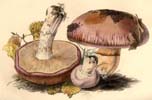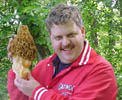Carolus Clusius (1526 - 1607)
Back to Author Index
Biography
Sources
Selected publications
Biography
1548 trains as a lawyer
collects plants for Rondelet, a physician and botanist at Montpellier.
translates (and rewrites) various books into latin
all his worldly goods confiscated for religious reasons; he flees the country, eventually ending up in Austria
1593 succeeds Dodoens as the chair of botany at the University of Leiden in the Netherlands, where he starts their (later famous) botanical garden
Clusius (also known as Carlus Clusius, Charles de L'Écluse, and Jules-Charles L'Écluse) is most famous among mycologists for a picture of a stinkhorn that Robert Gerard lifted and included in his "Gerard's Herbal"... but upside-down, because it looked more like a plant that way. This, of course, demonstrates the atrocious intellectual standard of the herbals of the time (or perhaps just Gerard's) but little else.
On a more substantive note, Clusius made many contacts while wandering Europe after fleeing France (he was a protestant, and the French Church went on one of its periodic rampages), and used them to obtain plants unavailable in Western Europe at the time: Isley credits him with the introduction of the peony, tulip, hyacinth and potato to Western European gardening, and likewise credits him with establishing the Netherlands as the tulip center of the world.
And on a more relevant note, the Fungorum Historia appendix to his Rariorum Plantarum Historia describes over a hundred fungi (including his famous stinkhorn), the most in one place for quite some time.
Back to top
Sources
Duane Isley (1994) One Hundred and One Botanists
Back to top
Selected Publications
Carolus Clusius (1601) Rarorium Plantarum Historia: Fungorum in Pannoniis observatorum brevia historia (A brief account of my observations of fungi in Panonia) pp. 211 - 295
Back to top











